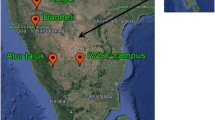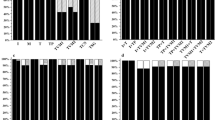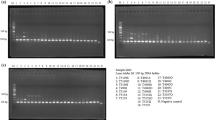Abstract
Context
East Indian sandalwood (Santalum album L.) in commercial markets is highly prone to adulteration. A number of cases were registered with regard to the adulteration of East Indian sandalwood, but the lack of technical tools for the precise species identification of the source wood stalled most of the court cases.
Aims
The standard DNA barcode regions, the rbcL, matK and trnH-psbA chloroplast genomic sequences recommended by the Consortium of Barcode of Life (COBOL) were analysed to distinguish wood adulterants of East Indian sandalwood.
Methods
Standard polymerase chain reactions with COBOL recommended primers were performed for all three barcode loci. The PCR products after gel elution were sequenced and alignments were performed using CLUSTALX.
Results
Single nucleotide polymorphisms (SNPs) identified with rbcL and trnH-psbA sequences of Erythroxylum monogynum Roxb. as well as with matK sequences of Osyris wightiana Wall ex. Wight could be efficiently utilized for the detection/monitoring of East Indian sandalwood adulterants. Among the two common adulterants O. wightiana and E. monogynum, the former was more similar to S. album and grouped together in the dendrogram.
Conclusion
The study recommends the exploitation of DNA barcoding technique using standard barcodes to trace sandalwood timber adulterants.



Similar content being viewed by others
References
Ananthapadmanabha HS (2012) Expert sandalwood marketing report, TFS sandalwood project report, pp 69–71
Anupama C, Balasundaran M, Sujanapal P (2012) Phylogenetic relationships of Santalum album and its adulterants as inferred from nuclear DNA sequences. Int J Agric For 2:150–156
Asif MJ, Cannon CH (2005) DNA extraction from processed wood: a case study for the identification of an endangered timber species (Gonystylus bancanus). Plant Mol Biol Report 23:185–192
Bhat KV, Balasundaran M, Balagopalan M (2006) Identification of Santalum album and Osyris lanceolata through morphological and biochemical characteristics and molecular markers to check adulteration. KFRI Res Rep 307:22p
Boner M, Sommer T, Erven C, Forstel H (2007) Stable isotopes as a tool to trace back the origin of wood. In: Proceedings of the international workshop, Fingerprinting methods for the identification of timber origins, October 8-9, Bonn/Germany, pp 47–57
Chase MW, Salamin N, Wilkinson M (2005) Land plants and DNA barcodes: short-term and long-term goals. Philos Trans R Soc Lond B Biol Sci 360:1889–1895
COBOL Plant Working Group (2009) A DNA barcode for land plants. Proc Nat Acad Sci 106:12794–12797
Costion C, Ford A, Cross H (2011) Plant DNA barcodes can accurately estimate species richness in poorly known floras. PLoS ONE 6: E26841. www.plosone.org
Degen B, Fladung, M (2008) Use of DNA-markers for tracing illegal logging. In: Degen B (ed) Proceedings of the international workshop “Fingerprinting methods for the identification of timber origins” October 8–9, Landbauforschung, VTI Agriculture and Forestry Research, Sonderheft 321, Germany, pp 6–14
Deguilloux MF, Premonge MH, Petit RJ (2002) Novel perspectives in wood certification and forensics: dry wood as a source of DNA. Proc R Soc Lond 269:1039–1046, Delhi
Fuji T (2007) Outline of the research project »Methods to identify wood species and origin of timber of Southeast Asia. Proceedings of the international symposium on development of improved methods to identify Shorea species wood and its origin, 19
Hall TA (1999) A user friendly biological sequence alignment editor and analysis program for Windows 95/98/NT. Nucleic Acid Symp Ser 41:95–98
Hebert PDN, Cywinska A, Ball SL (2003) Biological identifications through DNA barcodes. Proc R Soc Lond Biol Sci Series B 270:313–321
Hewson HJ, George AS (1984) Santalaceae. In: George AS (ed) Flora of Australia. Australian Government Publishing Service, Canberra, pp 29–67
Holmquist R (1983) Transitions and transversions in evolutionary descent: an approach to understanding. J Mol Evol 19:134–144
IUCN (2009) IUCN Red List of Threatened Species. Version 2009.1, www.iucnredlist.org
Kimura M (1980) A simple model for estimating evolutionary rates of base substitutions through comparative studies of nucleotide sequences. J Mol Evol 16:111–120
Larkin MA, Blackshields G, Brown NP (2007) Clustal W and ClustaL X version 2. Bioinformatics 23:2947–2948
Liepelt S, Sperisen C, Deguilloux MF (2006) Authenticated DNA from ancient wood remains. Ann Bot 98:1107–1111
Lowe AJ, Cross HB (2011) The application of DNA to timber tracking and origin verification. J Int Assoc Wood Anatomists 32:251–262
Lowe AJ, Wong KN, Tiong TS (2010) A DNA method to verify the integrity of timber supply chains, confirming the legal sourcing of Merbau timber from logging concession to sawmill. Silvae Genet 59:263–268
Oyen LPA, Dung NX (1999) Plant resources of south-east Asia No. 19, Essential-oil plants, Backhuys, Leiden, the Netherlands, 1999
Page T, Tate H, Bunt C, Potrawiak A, Berry A (2012) Opportunities for the smallholder sandalwood industry in Vanuatu. ACIAR Technical Reports No 79 Australian Centre for International Agricultural Research, Canberra. 67 p
Rachmayanti Y, Leinemann L, Gailing O (2006) Extraction, amplification and characterization of wood DNA from Dipterocarpaceae. Plant Mol Biol Rep 24:45–55
Shivji M, Clarke C, Pank M (2002) Genetic identification of pelagic shark body parts for conservation and trade monitoring. Conserv Biol 16:1036–1047
Shyaula SL (2012) A review on genus Osyris: phytochemical constituents and traditional uses. J Nat Pharm 3:61–70
Srimathi RA, Kulkarni HD, Ventkatesan K (1995) Recent advances in research and management of sandal (Santalum album L.) in India. Associated publishing Co, New Delhi, 1995
Tamura K, Dudley J, Nei M (2007) MEGA4: molecular evolutionary genetics analysis (MEGA) software version 4.0. Mol Biol Evol 24:1596–1599
Acknowledgments
We are grateful to the Kerala Forest Department (KFD) for permission to collect the samples. We would also like to thank the anonymous reviewers for helpful suggestions and comments on the manuscript.
Funding
The study was funded by Kerala State Council for Science, Technology and Environment (KSCSTE), Govt. of Kerala, India.
Author information
Authors and Affiliations
Corresponding author
Additional information
Handling Editor: Christophe PLOMION
Contribution of the co-authors
Suma Arun Dev: contributed towards designing and conducting wet lab experiments, writing paper and analysing the data
E.M. Muralidharan: involved in writing paper and coordination of project
P. Sujanapal: sample collections from the field site and identification
M. Balasundaran: wood sample collection and involved in writing paper
Rights and permissions
About this article
Cite this article
Dev, S.A., Muralidharan, E.M., Sujanapal, P. et al. Identification of market adulterants in East Indian sandalwood using DNA barcoding. Annals of Forest Science 71, 517–522 (2014). https://doi.org/10.1007/s13595-013-0354-0
Received:
Accepted:
Published:
Issue Date:
DOI: https://doi.org/10.1007/s13595-013-0354-0




